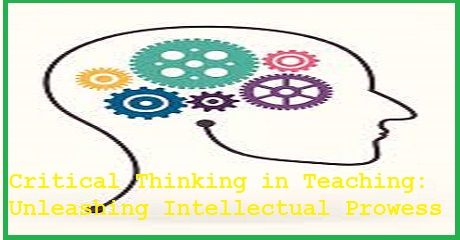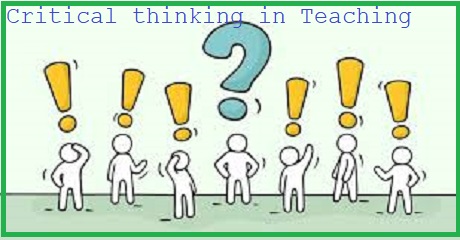Introduction:
Critical thinking in Teaching, the hallmark of intellectual rigor, takes center stage in the realm of teaching. Far beyond the memorization of facts, critical thinking propels students into a sphere of inquiry, analysis, and synthesis. It lays the foundation for a resilient and adaptable mindset, empowering learners to grapple with complexity and thrive in an era of constant change.
Foundations of Critical Thinking:
Critical thinking is a multidimensional cognitive process encompassing analysis, interpretation, evaluation, inference, explanation, and problem-solving. Rooted in a commitment to intellectual curiosity, it compels students to go beyond the surface and engage deeply with information.
Questioning the Status Quo:
At its essence, critical thinking is a call to question the status quo. It challenges students to interrogate assumptions, scrutinize evidence, and approach information with a discerning eye. This constant interrogation forms the bedrock of an inquisitive mind, ever-hungry for knowledge and understanding.
Application Across Disciplines:
One of the remarkable facets of critical thinking is its universality. It transcends disciplinary boundaries, finding relevance in the sciences, humanities, mathematics, and beyond. The skills developed through critical thinking—analytical reasoning, effective communication, and problem-solving—are applicable in every facet of education and life.
Teaching Strategies for Critical Thinking:
Educators bear the torch in fostering critical thinking. Socratic questioning, where open-ended queries stimulate discussion and exploration, is a powerful strategy. Problem-solving activities, collaborative projects, and class debates provide platforms for students to apply critical thinking skills, fostering an environment of intellectual engagement.
Assessment Beyond Memorization:
Traditional assessments often fall short in gauging true intellectual prowess. Critical thinking demands assessments that mirror real-world challenges. Essays, research projects, and presentations become instruments for students to showcase not only their acquired knowledge but also their ability to analyze, synthesize, and communicate complex ideas.

Cultivating Curiosity and Intellectual Courage:
At the core of critical thinking lies a culture of curiosity and intellectual courage. Educators must create an environment that not only permits but celebrates the fearless pursuit of understanding. When students are encouraged to explore beyond the familiar, intellectual resilience flourishes, preparing them for the uncertainties of an ever-changing world.
Real-World Relevance:
The significance of critical thinking extends far beyond the classroom walls. In a world where information is abundant but discernment is scarce, individuals equipped with robust critical thinking skills become adept problem solvers, decision-makers, and contributors to societal progress. Critical thinking is not just an academic pursuit; it is an essential life skill.
Conclusion:
In conclusion, critical thinking in teaching is not a pedagogical technique but a transformative ethos. It shapes students into analytical thinkers, effective communicators, and adaptable individuals poised to thrive in the complexities of an evolving world. As educators champion this mindset, they mold not just informed students but lifelong learners and agile thinkers prepared to navigate the intellectual challenges of the future.

Can you be more specific about the content of your article? After reading it, I still have some doubts. Hope you can help me.
BWER Company stands as a trusted name in Iraq’s weighbridge industry, offering innovative designs, reliable installations, and comprehensive support for all weighing requirements.
Can you be more specific about the content of your article? After reading it, I still have some doubts. Hope you can help me.
I don’t think the title of your article matches the content lol. Just kidding, mainly because I had some doubts after reading the article.
Your article helped me a lot, is there any more related content? Thanks!
2tw04u
I really like your writing style, superb info, thanks for posting :D. “Let every man mind his own business.” by Miguel de Cervantes.
Thanks for sharing. I read many of your blog posts, cool, your blog is very good.
Your article helped me a lot, is there any more related content? Thanks!
Great V I should definitely pronounce, impressed with your web site. I had no trouble navigating through all the tabs as well as related information ended up being truly simple to do to access. I recently found what I hoped for before you know it in the least. Quite unusual. Is likely to appreciate it for those who add forums or anything, website theme . a tones way for your customer to communicate. Nice task..
njlreo
Please let me know if you’re looking for a article author for your site. You have some really good posts and I feel I would be a good asset. If you ever want to take some of the load off, I’d absolutely love to write some articles for your blog in exchange for a link back to mine. Please blast me an email if interested. Regards!
It’s perfect time to make some plans for the long run and it’s time to be happy. I’ve read this post and if I may I wish to recommend you some fascinating issues or advice. Maybe you can write subsequent articles relating to this article. I wish to read even more issues about it!
After all, what a great site and informative posts, I will upload inbound link – bookmark this web site? Regards, Reader.
Your place is valueble for me. Thanks!…
Thank you for your sharing. I am worried that I lack creative ideas. It is your article that makes me full of hope. Thank you. But, I have a question, can you help me?
Greetings from Los angeles! I’m bored at work so I decided to browse your site on my iphone during lunch break. I love the information you provide here and can’t wait to take a look when I get home. I’m surprised at how fast your blog loaded on my cell phone .. I’m not even using WIFI, just 3G .. Anyways, fantastic blog!
I discovered your blog site on google and check a few of your early posts. Continue to keep up the very good operate. I just additional up your RSS feed to my MSN News Reader. Seeking forward to reading more from you later on!…
https://t.me/s/Official_1win_kanal/1278
Hmm is anyone else having problems with the pictures on this blog loading? I’m trying to find out if its a problem on my end or if it’s the blog. Any responses would be greatly appreciated.
Wow, superb blog layout! How long have you been blogging for? you make blogging look easy. The overall look of your website is excellent, let alone the content!
I like the helpful information you supply for your articles. I’ll bookmark your weblog and take a look at again right here regularly. I am moderately sure I’ll learn a lot of new stuff right here! Good luck for the following!
Your point of view caught my eye and was very interesting. Thanks. I have a question for you.
This web site is really a walk-through for all of the info you wanted about this and didn’t know who to ask. Glimpse here, and you’ll definitely discover it.
Can you be more specific about the content of your article? After reading it, I still have some doubts. Hope you can help me.
Useful info. Fortunate me I discovered your site by accident, and I’m surprised why this coincidence did not came about in advance! I bookmarked it.
Thanks for sharing. I read many of your blog posts, cool, your blog is very good. https://accounts.binance.com/fr/register-person?ref=T7KCZASX
I don’t think the title of your article matches the content lol. Just kidding, mainly because I had some doubts after reading the article.